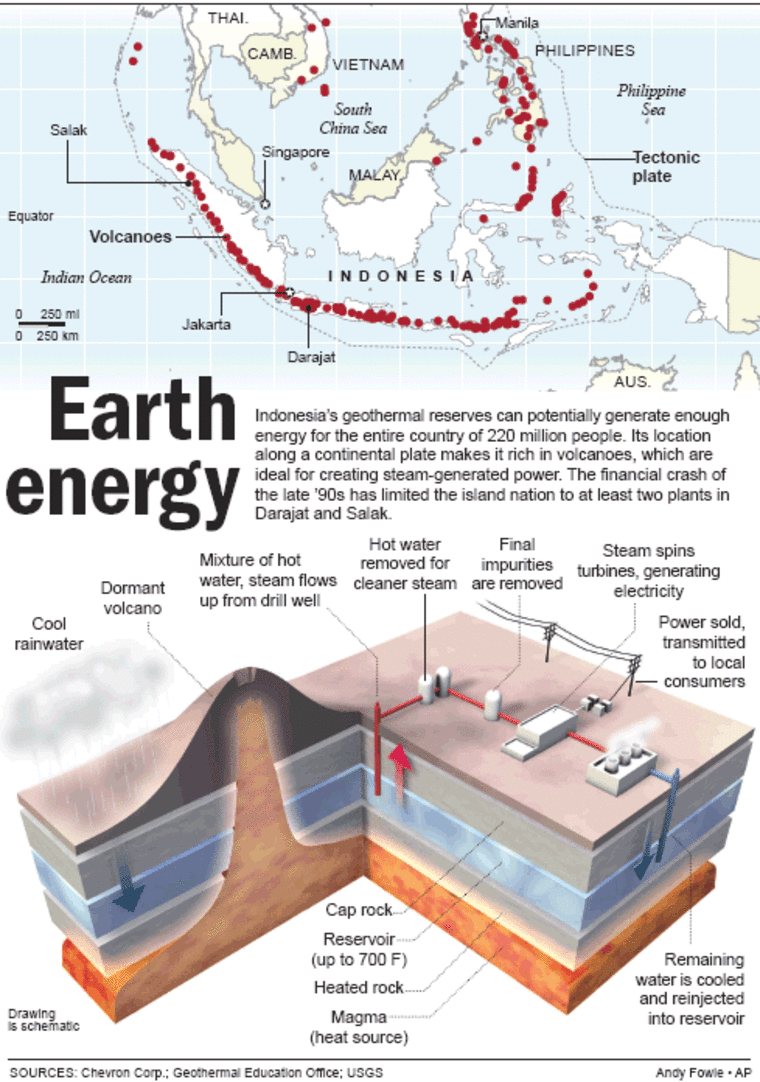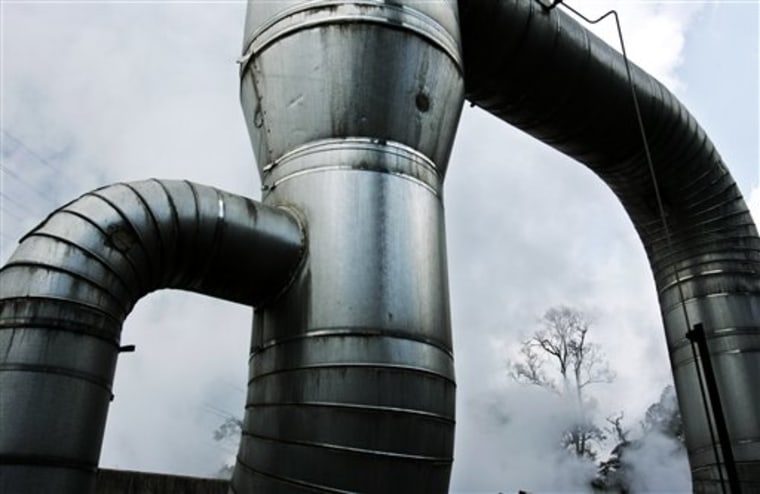Indonesia, land of earthquakes and volcanoes, is literally sitting on top of the solution for its energy needs: Vast reservoirs of hot water deep beneath the earth’s crust can be harnessed to generate electricity.
What’s more, it’s a clean, renewable energy source.
Yet the country continues to import millions of barrels of oil and fuel annually. Legal uncertainties, financial risks and government bureaucracy have repelled international investors from developing its geothermal resources.
Indonesia vows to pass within weeks regulations it hopes investors will find attractive, but after years of foot-dragging, not everyone is convinced.
Tapping geothermal energy makes sense for a cash-strapped government that still subsidizes fuel for its citizens, who are steadily demanding more power in the face of routine blackouts and brownouts.
The sprawling archipelago sits on what is believed to be the world’s largest geothermal resource base, with the potential to provide 21,000 megawatts — enough to supply all the energy needs for its 220 million people.
But so far existing plants have a combined capacity of just over 800 megawatts, or 4 percent of Indonesia’s potential, putting it behind the United States (2,100 MW), the Philippines (1,775 MW) and Mexico (975 MW).
Chevron still involved
About three-fifths comes from Chevron Corp., the only foreign business currently developing geothermal energy in Indonesia. The U.S. energy company says it’s able to do so largely because it operates on contracts signed decades ago under then-dictator Suharto.
“At that point the government had in place regulations that were very conducive to investment,” said Barry Andrews, president of Chevron’s Geothermal and Power, pointing to a strong central government and dependable tax regime. “We had certainty as to what to expect.”
Since the mid-1980s, Chevron has operated two fields, Salak and Darajat, on the main island of Java.
Its largest plant in Salak towers over the lush rainforest — home to gibbons, ant eaters and eagles — where massive pipes wind through some 25,000 acres of jungle, transporting steam that turns giant turbines to produce electricity.
The water is then returned to the underground reservoir and reheated by magma to temperatures as high as 570 degrees Fahrenheit, completing the renewable energy cycle.
Twenty years ago, nearly a dozen local and foreign companies — among them, Chevron and a company it bought last year, Unocal Corp. — were developing geothermal in partnership with the state-run electricity company PLN and a local private firm. Investors got a great deal because PLN agreed to annual minimum purchases at prices determined in dollars instead of the local currency, the rupiah.
But the 1997-98 Asian financial crash abruptly changed all that. International investors, who pumped billions of dollars into Indonesia before Suharto’s 1998 ouster, have been slow to return or simply refused.
Almost all geothermal projects were stopped or canceled when it became clear that PLN was not going to be able buy the electricity as promised, said Erik Layman of the California-based Layman consultancy Energy Associates Inc.
Some contracts were taken over by the government, which has done little since then to develop them, and the terms of other stalled projects, Salak and Darajat included, were re-negotiated at lower prices, he said.
“Many of these investors had expended hundreds of millions of dollars to bring projects on line before they were canceled,” said Layman, who was involved in Chevron’s Darajat project from 1985 to 1988 and CalEnergy’s Dieng, Patuha and Bali projects from 1994 to 1998.
MidAmerican Energy Holdings Co.’s CalEnergy took its case before international arbitrators and won — a move some analysts say is partly responsible for the government’s reluctance today to reopen the door too quickly.
Price difference
President Susilo Bambang Yudhoyono renewed pledges this year to promote alternative energy sources, but industry experts say price remains a huge obstacle.
Though long-term costs are low, the technology requires an upfront investment of more than $100 million. And because the energy must be used close to its source — unlike coal or oil, which can be exported — what a company gets for its electricity is key.
At present the cash-strapped government is offering just 4.5 cents kilowatt hours — around 30 percent less than the going rate in the United States, and as much as 2 cents lower than what the Suharto government had offered.
“At that price, we’re just not going to get new investment into the country,” Andrews said.
He said companies like his need help — either in higher prices or in major breaks in taxes or royalties — before committing to more projects.
While Indonesia passed a geothermal law in 2003, it has yet to approve regulations that will determine how much tax or royalties companies will have to pay, nor has it spelled out the role regional authorities will play following a post-Suharto power shift away from central government.
Sugiharto Harsoprayitno, director of the Ministry of Energy and Natural Resources’ geothermal department, acknowledges that it could take years for foreign investors to return and that prices couldn’t go much higher, because they are already in line with prices of electricity generated through other means.
“Instead of raising prices, we’re trying to find ways to reduce the cost of development,” he said.
Harsoprayitno said new regulations should be finalized within weeks and, while removing companies’ rights to take disputes before international arbitrators, should limit the “mess regional governments could make of things.”
He said taxes will likely also be reduced.
“Sooner or later we have to develop geothermal,” Harsoprayitno said. “It’s not the sole solution to our energy problems, but it would certainly help.”

